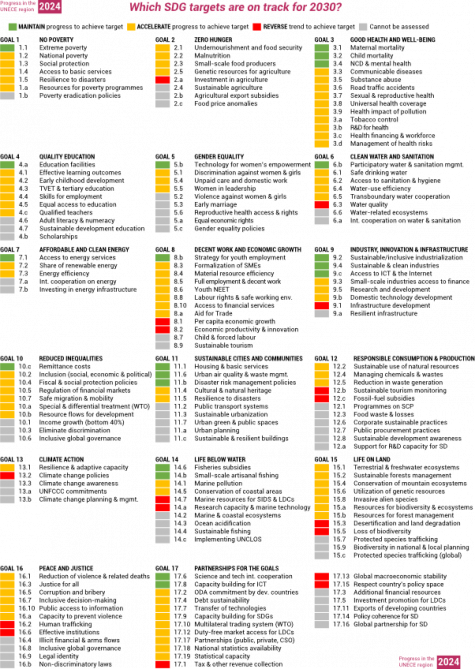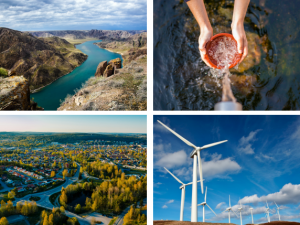Efforts to reach the Sustainable Development Goals (SDGs) by 2030 are facing strong headwinds from the impacts of the COVID-19 pandemic, shocks arising from climate change and the war against Ukraine, high interest rates and still-elevated inflation.
New data available for this year’s report on SDG progress in the UNECE Region better reveals the adverse impacts of these crises on the prospects for achieving the SDGs. The region – spanning across Europe, North America, the Caucasus and Central Asia, Türkiye and Israel – is on track to achieve only 20 targets (17% of the 117 measurable targets) by 2030. This is down from 21 targets in 2023, and 26 targets in 2022.
For 80 targets (up from 79 last year), progress needs to accelerate, and for 17 targets (up from 15 last year), the current trend must be reversed.

UNECE Executive Secretary Tatiana Molcean commented: "The alarm bells continue to ring louder the closer we get to 2030, as this year’s SDG report sadly reveals. With the second year of the war against Ukraine and a number of crises facing the region not yet reflected in the data, it is even more urgent to redouble efforts to get sustainable development back on track. Looking ahead to the Summit of the Future in September 2024 as a global opportunity to improve the underlying conditions for SDG acceleration, we must recognize that these Goals are guiding our actions towards a sustainable future.”
The fifth UNECE SDG progress report is the flagship document informing the deliberations of the upcoming Regional Forum on Sustainable Development (13-14 March).
Poverty, gender equality and education
The share of people living in poverty is decreasing in most countries, but not quickly enough. In one third of countries with data, more than 20% of the population still lives below the national income poverty threshold. One in ten persons live at below 50% of their country’s median income level – decreasing in two thirds of countries, but progress needs to be accelerated. Extreme poverty according to the internationally-defined poverty line (USD 2.15 per day) remains rare in the region.
Those at the highest risk of poverty, such as persons with disabilities and families with young children, are well covered by social protection in the UNECE region, but not everyone who would benefit from this type of support is receiving it. Less than half of unemployed persons across the region receive unemployment cash benefits.
The region is set to achieve targets on access to adequate housing and basic services as the proportion of urban population living in slums has decreased markedly in all countries with data.
Progress on gender equality can only be measured for less than half of targets.
The difference in time spent on household and care work between women and men is decreasing, but not fast enough. The share of women participating in political and economic life is increasing in nearly every country in the region, but women will remain underrepresented in leadership and decision-making positions in 2030 if current trends continue.
Inequalities between students lead to slow progress towards universal and quality education. While gender parity in reading and mathematics has been achieved, there are still large differences between urban and rural, native and foreign-born, and rich and poor students.
Schools are well equipped and most countries are already providing universal access to computers and the internet as well as other basic services in schools. Still, the share of youth and adults with ICT skills is only increasing slowly. Participation in education and training of working-age women and men is increasing slowly since 2015.
Health, well-being and nutrition
The region is set to achieve targets on child and maternal mortality and mortality from mental health and non-communicable diseases.
The prevalence of tobacco use has been decreasing in nearly all countries, but a quarter of all people aged 15 years and older across the region are still users.
The pace of progress on sexual and reproductive health is sluggish. Across the UNECE region, one quarter of women still have an unmet need for modern methods of family planning.
The share of the child population receiving recommended vaccinations is high, but the region is not on track to achieve universal access by 2030.
While the use of safely managed sanitation services is expanding, the current pace of improvement is not enough to attain their universal use by 2030.
Healthcare coverage is slowly improving, although households spend a larger part of their income on healthcare. The pandemic highlighted gaps and put stress on public health capacities.
Access to sufficient and nutritious food is not universal in the UNECE region. In one third of the countries, more than 10% of all adults experience food insecurity. Undernutrition in young children is rare.
Government spending on agriculture is continuously decreasing.
Energy and climate
Access to electricity is universal, and nearly all people in the region use clean fuels for cooking, heating and lighting. Reliance on renewable energy is increasing in more than three quarters of countries and energy efficiency is improving in nearly all countries. However, accelerated efforts are critical to ensure continued access to affordable and sustainable energy.
Fossil fuel subsidies have increased in most countries. This makes it unlikely that the region will achieve its targets to cut greenhouse gas emissions by 2030.
The declining trends in the proportion of passengers and freight transported by rail need to be reversed to achieve sustainable and resilient infrastructure.
The reduction of the carbon-intensity of economic production is on track.
National and local governments have comprehensively adopted disaster risk reduction strategies. The economic impact of disasters is becoming less severe, but the number of persons affected by disasters has continued to increase.
Water and environment
Access to safely managed drinking water is widespread, and 20 countries report levels above 99% of the population, but progress is slowing down, threatening the achievement of universal access by 2030.
The proportion of safely treated domestic wastewater flows is decreasing in more than half of countries.
Water use across the region is becoming more efficient and stress on freshwater resources is decreasing, but acceleration is needed for 2030. Transboundary water cooperation is strong, but the rate of implementation of integrated water resources management needs to increase.
Progress in reducing marine pollution and conserving coastal areas must be accelerated. The region must reverse trends to reach targets on sustainable fishing, and research and development on marine technology, which are moving in the wrong direction.
The region is progressing towards sustainable forest management, and forest area is increasing in most countries, but not quickly enough to reach the 2030 targets. Faster improvement is also needed in protecting terrestrial biodiversity areas and mountain ecosystems, adopting frameworks for sharing benefits and accessing genetic resources, reducing the impact of alien invasive species, and government aid to developing countries for conservation and sustainable use of biodiversity.
Air pollution in cities has gone down rapidly in nearly all countries. The region must accelerate progress on the sustainable use of natural resources and waste reduction and treatment.
Economy and industry
Following the immediate post-pandemic economic recovery, growth in GDP per capita and per employed person has been slowing across the region. Unemployment has declined in nearly all countries, but must pick up pace.
Macroeconomic stability has deteriorated, and the share of domestic budgets funded by domestic taxes declined in 2020 in nearly every country with data. For both targets, trends need to be reversed.
Medium- and high-tech manufacturing value has increased slowly in the UNECE region and exceeds half of the total production in 11 countries. To accelerate progress, investments in R&D need to be built up and access to finance for small-scale industries needs to improve.
The region has progressed well with inclusive and sustainable industrialization and access to information and communications technology is widespread. Both targets are on track for 2030.
Peace and partnerships
Countries in the region are getting safer. Homicide is rare in most countries and robberies are decreasing. Still, one quarter of people across countries with data do not feel safe walking alone after dark, and overall progress in reducing violence is too slow.
While previously assessed as being on track, newly available data on the prevalence of bribery show an upturn in most countries with data. Current trends must be reversed to eliminate human trafficking and strengthen public institutions.
Progress towards access to justice is mixed. The rate of robberies reported to the police is improving slightly, whereas two thirds of countries are seeing an increase in the share of unsentenced detainees in the prison population.
Decision-making bodies are becoming more reflective of the populations they but acceleration is needed to achieve proportionate representation of women and young people in parliaments and judiciaries by 2030.
Progress in development assistance to least developed countries, technology transfer, more open trade and improved market access for developing countries is slow.
Data availability for monitoring the SDGs is improving. The number of global SDG indicators that could not be assessed in the UNECE region because of insufficient availability of country data decreased from 77 in 2023 to 71 in this assessment. The region needs to intensify its investment in statistical capacity.

Note to editors
Data collected in 2020 or later make it possible to include trends since the onset of the COVID-19 pandemic for 143 out of the 160 indicators used in this year’s assessment. Data for 2022 are now available for 44 indicators, so the impact of the first year of the war against Ukraine is therefore partially reflected in the analyses. More information on the data can be found on the SDG dashboard.
The analysis, which compares estimated indicator values for 2030 with indicator target values, employs the same methodology used in previous reports and in assessments across the five United Nations regional commissions.


